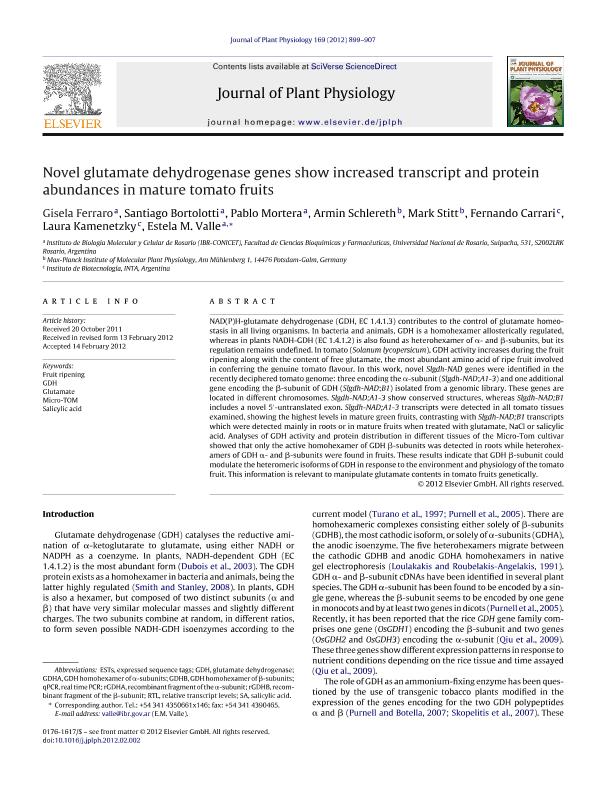Mostrar el registro sencillo del ítem
dc.contributor.author
Ferraro, Gisela

dc.contributor.author
Bortolotti, Santiago
dc.contributor.author
Mortera, Pablo

dc.contributor.author
Schlereth, Armin
dc.contributor.author
Stitt, Mark
dc.contributor.author
Carrari, Fernando Oscar

dc.contributor.author
Kamenetzky, Laura

dc.contributor.author
Valle, Estela Marta

dc.date.available
2019-01-08T21:08:40Z
dc.date.issued
2012-06
dc.identifier.citation
Ferraro, Gisela; Bortolotti, Santiago; Mortera, Pablo; Schlereth, Armin; Stitt, Mark; et al.; Novel glutamate dehydrogenase genes show increased transcript and protein abundances in mature tomato fruits; Elsevier Gmbh; Journal of Plant Physiology; 169; 9; 6-2012; 899-907
dc.identifier.issn
0176-1617
dc.identifier.uri
http://hdl.handle.net/11336/67735
dc.description.abstract
NAD(P)H-glutamate dehydrogenase (GDH, EC 1.4.1.3) contributes to the control of glutamate homeostasis in all living organisms. In bacteria and animals, GDH is a homohexamer allosterically regulated, whereas in plants NADH-GDH (EC 1.4.1.2) is also found as heterohexamer of α- and β-subunits, but its regulation remains undefined. In tomato (Solanum lycopersicum), GDH activity increases during the fruit ripening along with the content of free glutamate, the most abundant amino acid of ripe fruit involved in conferring the genuine tomato flavour. In this work, novel Slgdh-NAD genes were identified in the recently deciphered tomato genome: three encoding the α-subunit (Slgdh-NAD; A1-3) and one additional gene encoding the β-subunit of GDH (Slgdh-NAD; B1) isolated from a genomic library. These genes are located in different chromosomes. Slgdh-NAD;A1-3 show conserved structures, whereas Slgdh-NAD;B1 includes a novel 5'-untranslated exon. Slgdh-NAD;A1-3 transcripts were detected in all tomato tissues examined, showing the highest levels in mature green fruits, contrasting with Slgdh-NAD;B1 transcripts which were detected mainly in roots or in mature fruits when treated with glutamate, NaCl or salicylic acid. Analyses of GDH activity and protein distribution in different tissues of the Micro-Tom cultivar showed that only the active homohexamer of GDH β-subunits was detected in roots while heterohexamers of GDH α- and β-subunits were found in fruits. These results indicate that GDH β-subunit could modulate the heteromeric isoforms of GDH in response to the environment and physiology of the tomato fruit. This information is relevant to manipulate glutamate contents in tomato fruits genetically. © 2012 Elsevier GmbH.
dc.format
application/pdf
dc.language.iso
eng
dc.publisher
Elsevier Gmbh

dc.rights
info:eu-repo/semantics/openAccess
dc.rights.uri
https://creativecommons.org/licenses/by-nc-sa/2.5/ar/
dc.subject
Fruit Ripening
dc.subject
Gdh
dc.subject
Glutamate
dc.subject
Micro-Tom
dc.subject
Salicylic Acid
dc.subject.classification
Otras Ciencias Biológicas

dc.subject.classification
Ciencias Biológicas

dc.subject.classification
CIENCIAS NATURALES Y EXACTAS

dc.title
Novel glutamate dehydrogenase genes show increased transcript and protein abundances in mature tomato fruits
dc.type
info:eu-repo/semantics/article
dc.type
info:ar-repo/semantics/artículo
dc.type
info:eu-repo/semantics/publishedVersion
dc.date.updated
2019-01-04T16:39:46Z
dc.journal.volume
169
dc.journal.number
9
dc.journal.pagination
899-907
dc.journal.pais
Alemania

dc.journal.ciudad
Stuttgart
dc.description.fil
Fil: Ferraro, Gisela. Consejo Nacional de Investigaciones Científicas y Técnicas. Centro Científico Tecnológico Conicet - Rosario. Instituto de Biología Molecular y Celular de Rosario. Universidad Nacional de Rosario. Facultad de Ciencias Bioquímicas y Farmacéuticas. Instituto de Biología Molecular y Celular de Rosario; Argentina
dc.description.fil
Fil: Bortolotti, Santiago. Consejo Nacional de Investigaciones Científicas y Técnicas. Centro Científico Tecnológico Conicet - Rosario. Instituto de Biología Molecular y Celular de Rosario. Universidad Nacional de Rosario. Facultad de Ciencias Bioquímicas y Farmacéuticas. Instituto de Biología Molecular y Celular de Rosario; Argentina
dc.description.fil
Fil: Mortera, Pablo. Consejo Nacional de Investigaciones Científicas y Técnicas. Centro Científico Tecnológico Conicet - Rosario. Instituto de Biología Molecular y Celular de Rosario. Universidad Nacional de Rosario. Facultad de Ciencias Bioquímicas y Farmacéuticas. Instituto de Biología Molecular y Celular de Rosario; Argentina
dc.description.fil
Fil: Schlereth, Armin. Max-Planck Institute of Molecular Plant Physiology; Alemania
dc.description.fil
Fil: Stitt, Mark. Max-Planck Institute of Molecular Plant Physiology; Alemania
dc.description.fil
Fil: Carrari, Fernando Oscar. Instituto Nacional de Tecnología Agropecuaria. Centro de Investigación en Ciencias Veterinarias y Agronómicas. Instituto de Biotecnología; Argentina
dc.description.fil
Fil: Kamenetzky, Laura. Instituto Nacional de Tecnología Agropecuaria. Centro de Investigación en Ciencias Veterinarias y Agronómicas. Instituto de Biotecnología; Argentina
dc.description.fil
Fil: Valle, Estela Marta. Consejo Nacional de Investigaciones Científicas y Técnicas. Centro Científico Tecnológico Conicet - Rosario. Instituto de Biología Molecular y Celular de Rosario. Universidad Nacional de Rosario. Facultad de Ciencias Bioquímicas y Farmacéuticas. Instituto de Biología Molecular y Celular de Rosario; Argentina
dc.journal.title
Journal of Plant Physiology

dc.relation.alternativeid
info:eu-repo/semantics/altIdentifier/doi/https://dx.doi.org/10.1016/j.jplph.2012.02.002
dc.relation.alternativeid
info:eu-repo/semantics/altIdentifier/url/https://linkinghub.elsevier.com/retrieve/pii/S0176161712000880
Archivos asociados
